Today you’re going to learn various theories of the origin of the earth. First of all, You should know that all the concepts, hypotheses and theories propounded for the origin of the solar system are also applicable to the origin of the earth.
In this article, we will read a total of 8 theories of the origin of the universe.
- Gaseous hypothesis of Kant
- Nebular hypothesis of Laplace
- Planetesimal hypothesis of Chamberlin
- Jean and Jeffery’s tidal theory
- Russel’s binary Star Hypothesis
- Hoyle’s supernova hypothesis
- Schmidt’s interstellar hypothesis
- Big bang theory
1. Gaseous hypothesis of Kant
- Immanuel Kant, the German philosopher, presented his treatise entitled ‘The General Natural History and Theory of the Heaven or the Essay on the Working and Mechanical Origin of the Entire Universe on the Basis of Newtonian Laws’ in 1755.
- Kant claimed that his ‘gaseous hypothesis’ of the origin of the earth was based on the sound principles of Newton’s laws of gravitation and rotatory motion.
- In the beginning his hypothesis acclaimed world-wide appreciation but later on it was disproved as it was based on erroneous concepts and wrong application of Newtonian laws of gravitation.
- Inspite of severe criticism the hypothesis was considered a great step forward in the field of cosmogony and ‘he almost reverberated the mid-18th century with his words…Give me matter and I will build a world out of it.’
- Kant postulated his gaseous hypothesis of the origin of the earth on the basis of a few assumptions. He assumed that supernaturally created primordial hard matter was scattered in the universe.
- In fact, according to Kant there was a primeval, slowly rotating cloud of gas (now called a nebula) and matter comprised of very cold, solid and motionless particles.
- Nebula – It is a primordial (primitive) amorphous (without shape) mass of cloud of gas and dust.
- In terms of modern scientific language it can be said (but not described by Kant) that the temperature of primordial matter was near about -273 °C or absolute zero or 0 K. This was the reason that cold matter was initially motionless (according to the molecular theory of matter).
- He further assumed that the particles began to collide against each other under their mutual gravitational attractions. This mutual attraction and collision between the particles generated random motion in the primordial matter. Collision of the particles also generated friction which generated heat, with the result the temperature of the primordial matter started rising.
- He further argued that the random motion of the particles also generated rotatory motion in the primordial matter. Thus, the original cold and motionless cloud of matter became in due course a vast hot nebula and started spinning (rotating) around its axis.
- According to Kant with the increase in temperature, the random motion as well as the rate of collision among the particles also increased. This gave extra impetus of the rate of rotatory motion (spinning) of the primordial matter. The rise in temperature also changed the state of primordial matter from solid to gaseous particles. Thus, the initial primordial matter gradually changed in hot rotating nebula. With continuous rise in temperature and rate of rotatory motion the nebula started expanding in size.
- According to Immanuel Kant as the heat increased, the size of nebula increased and as the size of nebula increased, the angular velocity or rotatory speed further increased. Due to continuous increase in the size of nebula the rotatory speed became so fast that the centrifugal force (away from the centre) exceeded the attractional or centripetal force (directed towards the centre).
- The nebula started spinning so rapidly that an irregular ring was separated from the middle part of the nebula and was ultimately thrown off due to centrifugal force. By the repetition of the same process a system of concentric rings (nine) were separated from the nebula. The residual central mass of the nebula remained as the sun.
- The irregularity of the rings caused the development of the cores (knots) for the formation of the corresponding planets. In other words, all the matters of each ring were aggregated at a point to form a core or a knot which ultimately grew as a planet in due course of time. Thus, it is apparent that according to Kant the earth was formed due to aggregation of all the matter of the ring which was separated from the nebula due to centrifugal force.
- By the repetition of same process rings were separated from the newly formed planets and the materials of each ring were condensed to form satellites of the concerned planets. Thus, the whole solar system comprised of the sun (residual part of the rotating nebula), nine planets and their satellites were formed.
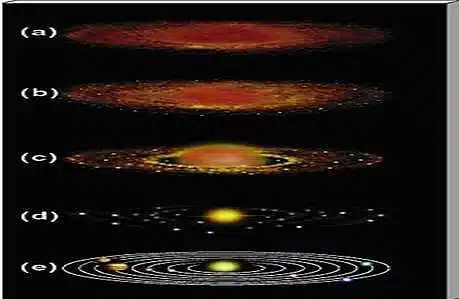
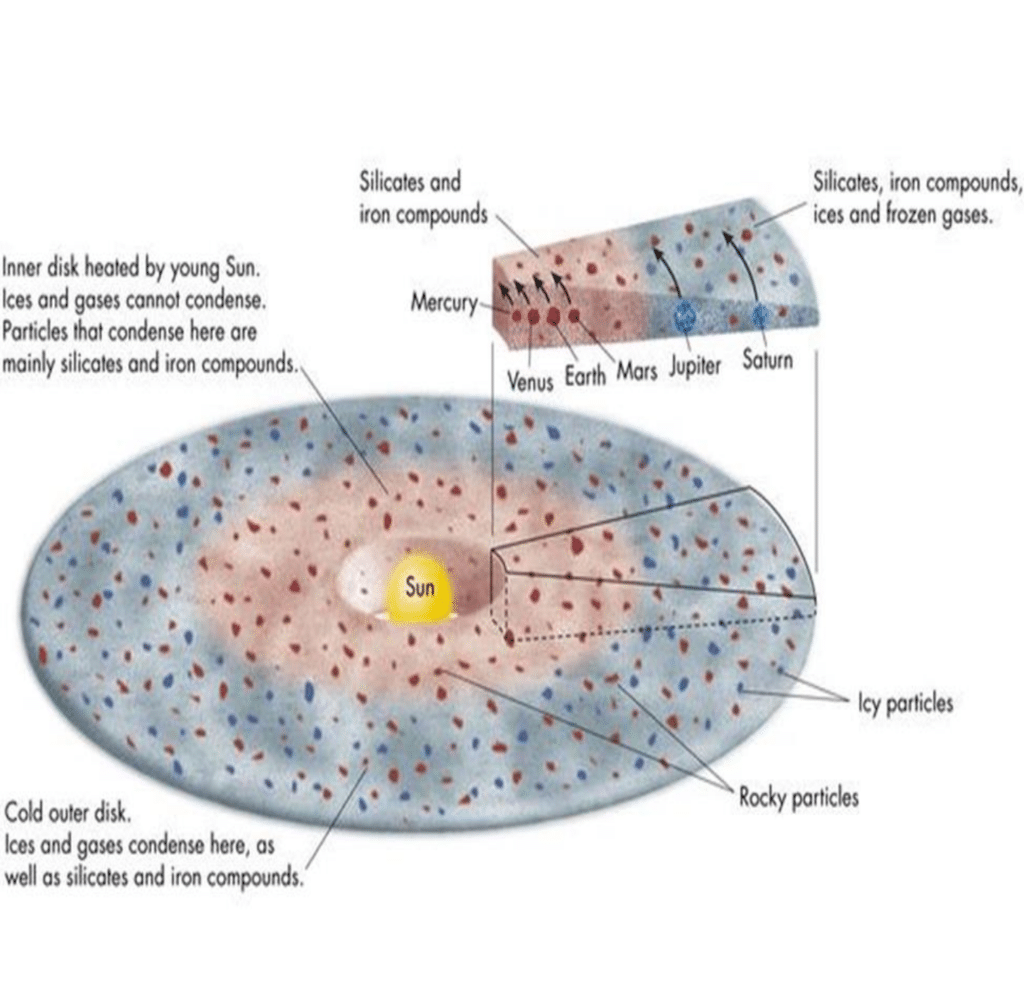
Evaluation
Though Immanuel Kant based his gaseous hypothesis on scientific principles (Newton’s law of gravitation) to solve the problem of the origin of the solar system and the earth but his hypothesis has been rendered baseless because it is based on several erroneous facts of science. In fact, Kant’s hypothesis was declared dynamically unsound:
- It was one of the basic assumptions of Kant’s hypothesis that there was primordial matter in the universe but he never explained the source of the origin of the primordial matter.
- Kant did not explain the source of energy to cause random motion of the particles of the primordial matter which were cold and motionless in the initial stage.
- According to Newton’s first law of motion ‘a body remains at rest, or if in motion it remains in uniform motion with constant speed, unless or until an external force is applied on it.’ The particles of the primordial matter, as assumed by Kant, were at rest and no external force was applied on them, then what was the cause for the random motion among the particles of primordial matter?
- The collision among the particles of the primordial matter can never generate rotatory motion in it. It is an erroneous statement of mechanism.
- It means that if anybody is rotating, the total amount of its angular momentum will always remain constant unless an external force is applied on the rotating body.
- This statement is erroneous as it is against the law of conservation of angular momentum.
Thus, the very foundation, on which Kant’s hypothesis was based, is proved unsound and wrong. However, the importance of Kant’s hypothesis lies in the fact that it was first scientific attempt for the explanation of the origin of the earth. In fact, Kant’s hypothesis paved the way for the postulation of nebular hypothesis by Laplace.
2. Nebular hypothesis of Laplace
- Laplace, a French scholar, proposed the “Nebular Hypothesis of Laplace,” which is one of the earliest theories on the origin of the earth. Laplace attempted to revise Kant’s Gaseous Hypothesis.
- In terms of the assumption of primordial matter, Laplace’s nebular hypothesis differs from Kant’s. Kant considered that primordial substance was composed of a cloud or nebula of cold static matter. Nebulae, according to Laplace, are made out of hot primordial matter. Pierre Simon de Laplace suggested the Nebular Hypothesis in 1796.
Assumptions
- He assumed that there was a huge and hot gaseous nebula in the space.
- From the very beginning huge and hot nebula was rotating on its axis.
- The nebula was continuously cooling due to loss of heat from its outer surface through the process of radiation and thus it was continuously reduced in size due to contraction on cooling.
According to Laplace
- Based on the above mentioned assumptions Laplace believed that the nebula was formed of gases rather than solids, and that everything, including the sun, stars, plants, and asteroids, was formed from the nebula cloud.
- Initially, there was a nebula cloud composed of Helium, Hydrogen, and dust particles, with a size similar to that of the present-day solar system.
- Since, Nebula was continuously reduced in size due to gradual loss of heat from the outer surface of the nebula through radiation.
- Thus, Reduction in the size and volume of the nebula increased the circular velocity (rotatory motion) of the nebula.
- Due to the increase in velocity, nebula started spinning at very fast speed and consequently the centrifugal force becomes so great that it exceeded the centripetal force.
- Consequently, the Outer surface was condensed due to excessive cooling and so it could not rotate with the still cooling and contracting the central nucleus of the nebula.
- And, Thus the outer ring was separated from the remaining part of the nebula.
- And this separated ring started moving around the nebula.
- Laplace further maintained that the original ring was divided into nine rings and each ring moved away from the outer ring.
- Thus, nine planets were formed from the nine rings and the remaining central nucleus of the nebula become the Sun.
Evaluations
- He did not describe the source of the origin of the nebula.
- He did not explain that, why did only 9 rings come out from irregular ring detached from the nebula?
- If the sun is the remaining nucleus of the nebula as claimed Laplace, it should have a small bulge around its middle part which would point out the probable separation of the irregular ring from the sun but there is no such bulge in the middle part of the sun.
- According to the nebular hypothesis all satellites should revolve in the direction of father planets but few satellites of Saturn and Jupiter revolve in the opposite direction of their father planets.
- The nebular hypothesis is unable to explain the peculiar distribution of present-day angular momentum in our solar system.
Outcome: The merit of the theory lies in the fact that it is the most acceptable explanation in explaining the layered structure of the earth’s interior.
3. The planetesimal hypothesis of Chamberlin (1905)
- The conroversy of peculiar redistribution of angular momentum in our solar system from the original angular momentum of Laplace’s nebula shattered the very basis of mono-parental or monistic concepts of the origin of the earth (and the planets). That is why , the idea of biparental or dualistic concept of the origin of the earth started gaining currency and respect among the scientists of the 1st quarter of the 20th century. Planetesimal hypothesis propounded jointly by Chamberlin and Moulton belongs to the dualistic concepts of the origin of the earth.
- Planetesimal hypothesis not only explains the origin of the earth but also throws light on the structure of the earth, the origin of its atmosphere and continents and ocean basins.
- Unlike monistic concept (e.g. gaseous hypothesis of Immanuel Kant and nebular hypothesis of Laplace) the planetesimal hypothesis envisaged the origin of the solar system (and the earth) with the help of two heavenly bodies.
- According to Chamberlin initially there were two heavenly bodies (stars) in the universe –
- Proto-Sun
- and its Companion Star or Intruding star
- The behavior and properties of proto-sun were not like other stars, It was formed of very small particles which were cold and solid. Thus, the proto-sun, unlike Laplace’s nebula, was not hot and gaseous rather it was formed of solid particles and was cold and circular in shape. There was another star, termed as ‘intruding star’ or ‘companion star which was destined to pass very close the proto-sun.
- When the intruding star came very close to the the Proto-Sun infinite number of small particles were detached from the outer surface of proto-sun due to massive gravitational pull exerted by the giant intruding star. This matter which is dust, gases, rock fragments eventually accrete forming planets & other celestial bodies that revolve around the proto sun.
- Initially, the detached particles or planetesimals were just like dust particles. The planetesimals were not of uniform size rather a few planetesimals around the proto-sun were of fairly big size. These larger planetesimals became nuclei for the formation of future possible planets. Gradually, large planetesimals started attracting small planetesimals.
- Thus, numerous small planetesimals were accreted (added) to the nuclei of large planetesimals and ultimately these large planetesimals grew in the form of planets due to continuous accretion of infinite number of planetsimals. With the passage of time, the remaining proto-sun changed into the present-day sun. The satellites of the planets were created due to the repetition of the same processes and mechanisms.
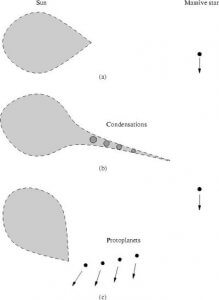
4. Jean and Jeffery’s tidal theory
- This theory is somewhat similar to Chamberlin’s theory that an intruding star ejects matter from the proto sun. Chamberlin, in his theory, had assumed the proto sun to be initially as a cold body whereas the Tidal theory assumes the proto sun to be hot and incandescent.
- According to Tidal theory, the matter ejected are not randomly thrown dust, gases, planetesimal.
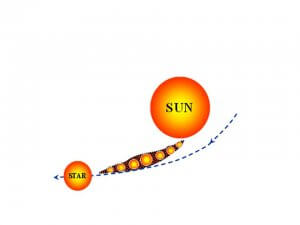
- The ejected matter was in the shape of a cigar and was called Filament from which the planets & other celestial bodies accrete.
- This theory is the best interpretation in explaining the sizes of the planets as they have arranged themselves away from the sun.
5. Russel’s binary Star Hypothesis
- There is a binary star system (two stars coupled together and rotating around a fixed center of mass).
- The intruding star comes close to the binary stars & eject matter from one of the stars. (It doesn’t explain what happened to the intruding star and the remainant of the star from which matter got ejected.)
- The ejected matter circulates into planets and revolves around the proto sun.
- This theory is convenient to explain why the composition of planets is different from the sun.
6. Hoyle’s supernova hypothesis
- According to Hoyle initially there were two stars in the universe –
- Primitive Sun and
- Companion star
- The companion star was giant and later on became supernova due to nuclear reaction.
- Over time, all of the hydrogen nuclei of companion star were consumed in the process of nuclear reaction and it collapsed and violently exploded
- The Violent explosion of companion star resulted in the spread of enormous mass of dust which started revolving around the primitive sun in the form of a circular disc
- The matter of this disc became building material for the formation of the future of planets.
- Thus, the planets of our solar system were formed due to condensation of the matter of the disc.
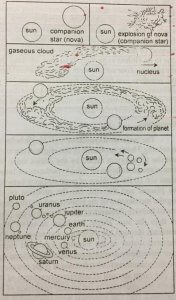
7. Schmidt’s interstellar hypothesis
- According to this theory, the initial universe comprised of stars & randomly distributed matter filling up the space in between.
- According to Schimidt, this dark matter, started to revolve around the primitive rotating sun and gradually the dark matter stars accreting & condensing & thus forming the solar system.
- Though Schimidt did not explain the mode of origin of these dark matters. These dark matters were called ‘inter-stellar dusts’ by Schimidt.
- This theory may be considered as explaining the processes that preceded the Nebular accretionary process of Laplace & Kant.
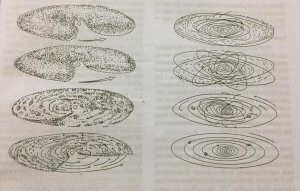
8. BIG BANG THEORY
Big Bang theory’s idea was first given by George Le Naitre in the 1920s & was gradually contributed by many scientists. But an important role was played by Gamenov (1970’s).
According to this theory, Everything in the universe has emerged from a point known as the singularity, 15 billion years ago.
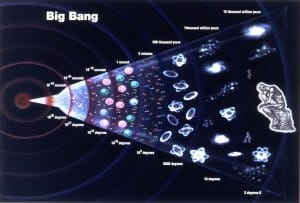
The galaxies moved apart from one another as the empty space between them expanded.
Theory:
The universe expanded from a very high density & high-temperature state.
There was a major cosmic explosion 13-15 bn yrs ago from which all the matter of the universe was thrown out which eventually accreted to form stars, solar system and celestial bodies.
Evidence in support:
- Red Shift: As an object (light) moves away from us, its wavelength increases & shift to the Red end of the spectrum (Called Red Shift).
- CBMR: Electromagnetic Radiation which was present shortly after the big bang, is now observed as background microwave radiation.

Nice presentation👍👍
Thanks, Keep reading
Good morning sir, optional geography’s complete notes mil sakte hai printed
Check out this page https://lotusarise.myinstamojo.com/
good info
Nice notes
Sir, please provide notes for Origin & evolution of earth’s crust.. These are for just origin & evolution of earth.
neocatastrophism plase send not
Please add origin and evolution of Earth’s crust notes
halo sir..our upsc cse syllabus mentioned ORIGIN & EVOLUTION OF EARTH CRUST……How earth’s continental crust & oceanic crust origin? and evolution?….pls explain this also……..thanks a lot